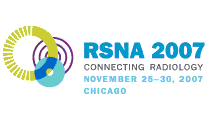
Abstract Archives of the RSNA, 2007
Ngoc Nhu Le BS, Presenter: Nothing to Disclose
Gary M. Nesbit MD, Abstract Co-Author: Nothing to Disclose
Kim J. Burchiel MD, Abstract Co-Author: Nothing to Disclose
Jonathan Miller MD, Abstract Co-Author: Nothing to Disclose
Bronwyn Elizabeth Hamilton MD, Abstract Co-Author: Nothing to Disclose
Most imaging protocols for trigeminal neuralgia (TN) include MRA with T2 and enhanced T1 images, since gadolinium enhancement is considered important for differentiating arteries from veins. Balanced fast field echo (BFFE) is a heavily T2-weighted high resolution and high contrast technique, which provides excellent anatomical detail, potentially superior to MRA and enhanced scans combined.
Two neuroradiologists blinded to clinical data retrospectively and independently reviewed BFFE images, from 3T MR studies in 18 patients referred for and surgically treated for TN from 2006 to 2007. They were instructed to predict the type of (arterial versus venous) and degree of vascular compression for each side based on only the BFFE sequence, although interactive multiplanar reformations (MPR) were allowed. Vessels were scored on a 4 point grading scale based on their distance from and effect on the cisternal trigeminal nerve (CN V): 0 = distance > 3 mm; 1 = < 3 mm; 2 = nerve contact; 3 = nerve deformity. The highest graded vessel was considered the causative lesion. Vessels included but scored lower by grading were considered non-causative. These results were compared to surgical findings for the symptomatic side.
Subjects included 6 males and 12 females ranging in age from 26-80 years. Surgery identified a total of 22 abnormal vessels for 13 right-sided and 5 left-sided TN patients. Four patients had both an arterial and venous compression. Correct predictions by BFFE compared to surgical decompression were: 17/22 (77.3%) and 18/22 (81.8%) vessels for each reviewer (mean 79.6%).
Review of unenhanced BFFE images alone in patients with TN demonstrated a high degree of accuracy (79.6%) for differentiating arterial versus venous compression of the cisternal CN V, suggesting that a conventional mutilsequence enhanced imaging protocol may not be necessary.
BFFE provides excellent depiction of vascular anatomy, allowing differentiation of arteries and veins for pre-operative evaluation in TN, potentially reducing the need for enhanced sequences and MRA.
Le, N,
Nesbit, G,
Burchiel, K,
Miller, J,
Hamilton, B,
Differentiating Arterial from Venous Compression in Trigeminal Neuralgia Using 3T Balanced Fast Field Echo (BFFE) Alone Compared to Surgical Results. Radiological Society of North America 2007 Scientific Assembly and Annual Meeting, November 25 - November 30, 2007 ,Chicago IL.
http://archive.rsna.org/2007/5009791.html

